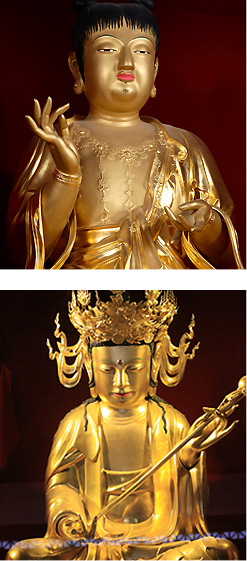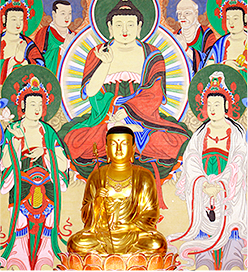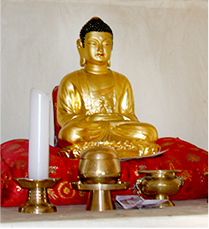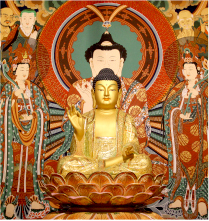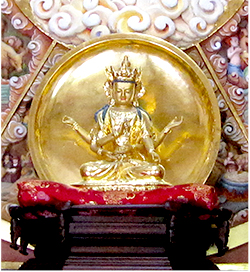The history of Sangwonsa Temple begun when prince Hyomyung and Bochun hid out in Odaesan Mountain after they get shoved out of the throne.
After they met Manjusri in person, Hyonmyung became King Sungdeock and he stabilized the throne of Silla Dynasty. Since he believed he was indebted to Manjusri, he built and restored the temple to repay the favor of Manjusri.
Originally, the temple was called Jinyeowon.
There was no record found about Sangwonsa Temple until the end of Koryeo Dynasty.
In the beginning of Joseon Dynasty, the temple caught people's attentions for it became a place performing rituals that lead spirits to the heaven.
At that time King Sejo usurped the throne of King Danjong, King Sejo saw the mother of Danjong cursed him in his dream. After he had that strange dream, he got a skin disease. He came to Sangwonsa Temple to take a rest. One day, he took a bath at the stream in front of the temple, and he encountered the present of Manjusari.
A little boy helped him to take a bath in the stream. When Sejo told the little boy not to tell anyone that he saw the king. Then, the little boy told Sejo that do not tell anyone that he saw him and disappeared. After the little boy disappeared, he realized that the boy was the present of Manjusri. To memory this miracle incident, King Sejo ordered to make a statue and paint a painting of Munsoodongja (the present of Manjusri).
The statue is still can be seen in Sangwonsa Temple and designated as a National Treasure No.221. In 1984. The a bloodstained clothe of King Sejo (it is designated as a National Treasure No.793) was found from the inside of the statue and the legend became a true story. The temple was almost burnt down during Korean War, but Master Hanam saved it at the risk of his life.
This story was based on the essay ŌĆśHow to liveŌĆØ written by Mr. Son, and presented in a schoolbook. Master Hanam represents Korean Buddhism and he had devoted for 27 years in Sangwonsa Temple until he entered into nirvana.
After they met Manjusri in person, Hyonmyung became King Sungdeock and he stabilized the throne of Silla Dynasty. Since he believed he was indebted to Manjusri, he built and restored the temple to repay the favor of Manjusri.
Originally, the temple was called Jinyeowon.
There was no record found about Sangwonsa Temple until the end of Koryeo Dynasty.
In the beginning of Joseon Dynasty, the temple caught people's attentions for it became a place performing rituals that lead spirits to the heaven.
At that time King Sejo usurped the throne of King Danjong, King Sejo saw the mother of Danjong cursed him in his dream. After he had that strange dream, he got a skin disease. He came to Sangwonsa Temple to take a rest. One day, he took a bath at the stream in front of the temple, and he encountered the present of Manjusari.
A little boy helped him to take a bath in the stream. When Sejo told the little boy not to tell anyone that he saw the king. Then, the little boy told Sejo that do not tell anyone that he saw him and disappeared. After the little boy disappeared, he realized that the boy was the present of Manjusri. To memory this miracle incident, King Sejo ordered to make a statue and paint a painting of Munsoodongja (the present of Manjusri).
The statue is still can be seen in Sangwonsa Temple and designated as a National Treasure No.221. In 1984. The a bloodstained clothe of King Sejo (it is designated as a National Treasure No.793) was found from the inside of the statue and the legend became a true story. The temple was almost burnt down during Korean War, but Master Hanam saved it at the risk of his life.
This story was based on the essay ŌĆśHow to liveŌĆØ written by Mr. Son, and presented in a schoolbook. Master Hanam represents Korean Buddhism and he had devoted for 27 years in Sangwonsa Temple until he entered into nirvana.

The name of Odae borrowed from Odaesan Mountain in China, which means a five peaks mountain: four sides and the middle. Joongdae Sajaam is situated on the middle peak and it holds Vairocana Buddha and Manjusri. Vairocana Buddha is the central figure of a trinity attended by Manjusri and Samantabhadra Bodhisattvas. According to Odae religion, there was a painting of 10000 Manjusri. It was built along the cliff and made a magnificent view.
Even though it is a small temple, it has been famed for having Jeokmyulbogung Temple that the piece of the BuddhaŌĆÖs skull was enshrined in its temple. Jeokmyulbogung Temple is known for one of the two temples that contribute to make a foundation of the religion of ŌĆ£BogungŌĆØ(a temple holds sarira of the BuddhaŌĆÖs) with Tongdosa Temple.
It says, The place where Jeokmyulbogung Temple situates is the best among the temples in high mountains, and so does Tongdosa Temple among the temples in low mountains. Jeokmyulbogung Temple used the word Jeokmyulbogung first as a name of temple, that is, Jeokmyulbogung Temple in Joongdae is the origin of jeokmyulbogungs in Korea.
Gwaneumam Temple is situated on the east peak of Odaesan Mountain. According to Odae Religion, there was a painting of 10000 of Avalokitesvara; and this hinted that the belief of Avalokitesvara started from there.
During Unified Silla Dynasty, Master Goojeong lived in Gwaneumsa Temple. He installed and removed the rice pot 9 times a day as his master asked him to do so. Finally he realized and found enlightment throught doing that simple and repetitive conduct that his master asked. There still some traces remained where Master Goojeong was doing acetic practices near Gwaneumam Temple.
The temple was burnt down during Korean War, and rebuilt in1971. In 1991 it was repaired and restored by monk Wolmyun.
Jijangam Temple is located on the east peak of Odaesan Mountain.There was a painting of 10000 of Ksitigarbha and people prayed for the belief of Jijang according to Odae Religion.
Ksitigarbha is the Bodhisattva of relieving the suffering of the nether world. He vowed not to become a Buddha until all people who are suffering in the hell are saved and go to heaven. He usually presents wearing a blue hood or has closely-cropped hair, and holds in one hand a staff or a sistrum, and in the other, a jewel.
Originally Jijangam Temple was located much far in the mountain but moved current location due to the environmental changes.
Ksitigarbha is the Bodhisattva of relieving the suffering of the nether world. He vowed not to become a Buddha until all people who are suffering in the hell are saved and go to heaven. He usually presents wearing a blue hood or has closely-cropped hair, and holds in one hand a staff or a sistrum, and in the other, a jewel.
Originally Jijangam Temple was located much far in the mountain but moved current location due to the environmental changes.
Youmbulam the old name of Soojeongam Temple enshrined Amithabha Buddha who is the Buddha of infinite light and governs the pure land, the heaven.
There was a painting of 10000 Daesejibosal and people prayed for the world of Buddha.
The meaning of Soojeong is the best water. Wootongsu the fountain from Soojeongan Temple was considered as the origin of Hangang River together with Geomgangyeon Pond.
Mireukam Temple is the temple located in the highest place. In Samkukyoosa, it says there were 500 Nahan enshrined and worshipped.
However, in Odaesansajukki says, a painting of 10000 of Maitreya Bodhisattiva was enshrined in Mireukam Temple originally. Nobody knows how we could have those two different records.
Now, it is called the temple of Maitreya Bodhisattiva and it is considered as the center of Maitreya faith.
In the middle of Joseon Dynasty, Master Samyungdang rebuilt Woljeongsa Temple while he stayed in Odaesan Mountain. At that time Master Samyungdang stayed Younggamam and he built Jongbongam Temple near Younggamam Temple. Jongbong named after his own name.
After the Japanese invasion of Joseon Dynasty in 1592, the archives building near the palace burnt down. The government decided that the new archives building should be placed in a good spot deep in mountainous place. Master Samyung who distinguished himself in the battle proposed Younggamsa in Odaesan Mountain as the best spot for the new archives building and the proposal was taken.The new archives building was built in Odaesan Mountain on the place where Younggamam Temple was.
Sagak kept the annals of Joseon Dynasty was in front and Sunwonbogak kept the items used by Joseon Royal family was in back. Sujiksa was built nearby the Archives Building of Joseon Dynasty and protected the building.
Sago was invaded during Japanese Colonial era. Jeongnyeom, the current chief monk of Woljeongsa Temple, have kept reclaiming those invaded properties. His effort was rewarded and the Annals of the Joseon Dynasty was returned in 2006 and in 2011, Joseon royal protocols was also returned.
Younggamam Temple was disappeared since Sago was built and recently it has been rebuilt behind Sago with the new name, Younggamsa Temple. Now, Sago stands along with Younggamsa Temple; the front and the rear.
Yooksooam Temple is called for the temple enshrined a six-handed Tibetan Bodhisattva from Esoteric Buddhism. During Koryeo Dynasty, Korean Buddhism influenced by Tibeta Buddhism and the trace was found up until Joseon Dynasty.
The temple is close by Woljeongsa Temple and it is the place where Master Tanheo settled after Korean War. Even though it is near Woljeongsa Temple, it is quite different with Woljeongsa Temple and it has its own unique scenes and atmosphere.


